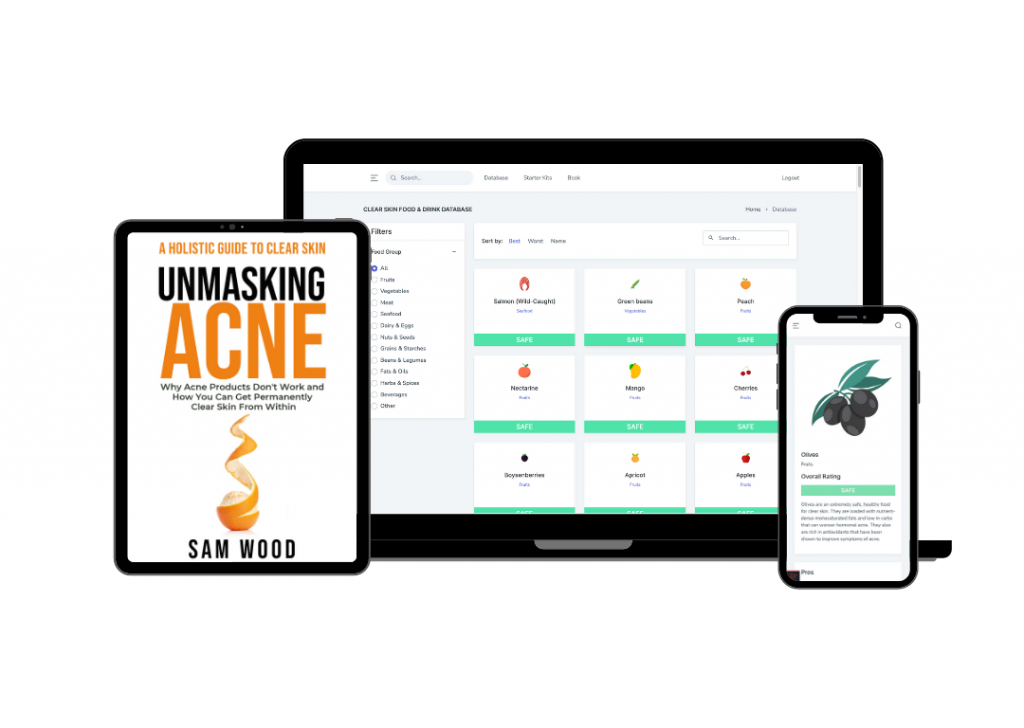If you’re a smoker or vaper, you’ll probably already be aware of the various health risks and hazards associated with the habit. If you’re a vaper, you might feel reassured that your e-cigarette doesn’t contain tobacco; however, vape pens still contain nicotine. So like tobacco, vaping can still lead to premature aging, lung damage and general skin damage.
However, the question I’m going to be discussing today is – does nicotine and vaping cause acne?
While the research is quite limited when it comes to acne and vaping, we’re going to discuss what vaping does to the body, whether vaping can cause hormonal acne, and what other factors might lead you to develop a breakout while using vape pens.
So, Does Nicotine and Vaping Cause Acne?
When it comes to smoking habits, we already know that smoking tobacco-based cigarettes is awful for your skin – and your health. As I discussed in one of my other articles, prolonged tobacco use can exacerbate inflammatory acne, not to mention increase the risk of developing various cancers and other diseases.
So, what about vaping? Does vaping cause acne?
Not exactly. While vaping does contain nicotine, there is no scientific evidence to suggest that vaping (or nicotine) can directly cause an increase in oil production and therefore increase breakouts.
However, vaping can actually still cause acne.
When you smoke a vape cigarette, you’re inhaling numerous unhealthy chemicals and toxins that can settle in the skin, leading to inflammation, damaging your skin’s barrier and eventually contributing to the development of acne breakouts.
Vaping, tobacco & nicotine usage have a net negative impact on virtually all aspects of your health, and your skin is no exception. Both tobacco and nicotine usage cause an inflammatory response all throughout the body and which leads to oxidative stress and a disruption of normal hormone function. This can cause excessive sebum oil production, which in turn leads to clogged pores and acne breakouts.
Dr. Anna Chacon
What’s Inside E-Cigs?
While vape pens and e-cigarettes don’t contain tobacco, most contain nicotine, propylene glycol, various flavorings and various carcinogens. Even when a vape pen markets itself as “nicotine-free,” take this statement with a pinch of salt.
As of 2022, the FDA is yet to introduce regulations on e-cigarettes, so there are currently no government-regulated standards that determine what is considered a “safe” or “unsafe” vape pen.
What we do know is that vape pens contain just as many toxic chemicals as regular cigarettes, including diacetyl, nickel, lead and various toxic carcinogens. While e-cigarettes are often marketed as a “healthy” alternative to smoking tobacco cigarettes, vaping should be considered a temporary solution as you try to quit tobacco cigarettes.
Vaping Side Effects: What Does Vaping Do To The Skin?
Long-term vaping is associated with several side-effects and can contribute to the following problems:
Inflammation
When your skin is inflamed, you’re going to find it much more difficult to treat any existing acne. When inflammation occurs in the skin, it delays the skin’s natural heal-and-repair process, exacerbating any skin conditions already present on the skin.
For example, if you suffer from skin conditions such as rosacea or eczema, skin inflammation is only going to make these conditions worse and prolong the healing process. Similarly, inflammation on acne-prone skin is bad for two reasons:
1. Inflammation is linked with increased breakouts and increased oil production.
2. Smoking will impact your skin’s wound-healing capacities, making it take longer for any acne scars to heal.
If you’re temporarily vaping while you wean yourself off tobacco-based cigarettes, you might find it useful to take a look at my breakdown of inflammation-causing foods in my acne resource guide and limit them in your diet during this time.
Skin Barrier Damage
Prolonged vape use has also been linked to long-term damage to the skin’s barrier. Your skin’s barrier is important because it protects your pores from becoming easily clogged, protects against external damage and prevents your skin from being penetrated by various toxins.
Long-term vape use can eventually lead to the breakdown of the skin’s natural barrier, which can lead to more frequent breakouts and recurring problems with acne and chronically clogged pores. A damaged skin barrier can also result in the breakdown of collagen, resulting in premature aging and more prominent acne scars.
Dry Skin and Oil Overproduction
Another side effect of vaping is chronic skin dryness: if you’re smoking Juul cigarettes, the liquid used in the vape pen can dehydrate your skin. If you already have acne-prone skin, having chronically dry skin will de-regulate your skin’s oil production, potentially resulting in your body overproducing sebum and causing acne breakouts.
As I talked about in my article discussing the effects of marijuana on the skin, smoking weed can dehydrate the skin and lead to a spike in oil production, resulting in breakouts.
Can Vaping Cause Hormonal Acne?
If you’re noticing lots of spots and acne around your mouth, you might think that hormonal acne is to blame. Given that hormonal acne tends to occur around the lower half of the face, I can’t blame you for thinking that your hormones are out of whack and causing breakouts.
However, vaping can actually cause these spots. Vaping can cause spots around the mouth and chin not due to the chemicals or nicotine inside, but because the vape pen is constantly touching your face and mouth.
As those of us with acne-prone skin know, touching your face is a massive no-no. Therefore, repeatedly passing a vape pen across your lower face can spread bacteria, clog pores and contribute to acne.
Think of all the places your vape pen is before you use it – on tables, in your pocket, in a dirty rucksack or handbag. The bacteria that your vape pen comes into contact with can then linger on the pen and cause spots on your face. Make sure to wash your vape pen regularly, and FYI: never share a vape pen, even with friends.
Vaping and Cystic Acne
If you have cystic acne, vaping can be disastrous for the skin’s natural healing process. Cystic acne is categorized by large, painful cyst or cyst-like spots on the skin, and is typically caused by bacteria and excess oil clogging the pores.
If you’re a long-term vaper and already suffering with cystic acne, you’ll be damaging your skin’s natural barrier, making way for bacteria to sneak through and clog your pores even easier than before. Cystic acne can already be a sign of a weak or damaged barrier, so damaging it further will only exacerbate your cystic acne.
Not only can vaping increase the number of breakouts you experience in any given period, but the long-term consequences of skin inflammation can also make it difficult for your acne scars to repair themselves naturally. When the skin’s ability to fight inflammation is impeded, your acne scars will take longer to heal.
Can Quitting Vaping Cause Acne?
While quitting vaping alone isn’t going to cause acne, some former smokers find that quitting nicotine can lead to some unpleasant side effects.
When faced with nicotine withdrawal, many former smokers increase their calorie intake, often opting for the sugariest and fattiest foods to compensate for the lack of nicotine rush. In fact, the average quitter gains around 5-10lbs when they first stop smoking. This weight gain does appear to be temporary, and most quitters will lose the extra lbs once the nicotine withdrawal has worn off.
However, by consuming excess calories and sugar, your body’s blood sugar will spike and release insulin. This spike in insulin can then cause your oil glands to overproduce sebum. The results? Yup – a nasty breakout. Combined with the stress induced from the nicotine withdrawal, quitting smoking can take a toll on your skin.
So, as unfair as it may seem, quitting smoking can actually cause a temporary increase in acne breakouts. But don’t worry – this isn’t a call to keep smoking for the good of your skin!
In fact, it simply means that if you’re going to quit smoking nicotine (whether it be from a tobacco-based cigarette or a vape pen) you’re going to need to plan your diet accordingly so that you don’t experience a nasty breakout.
In my eBook, I’ve talked a lot about using your diet as a means of reducing acne and obtaining clear skin the natural way. If you’re vaping or planning on quitting vaping, you can also make use of this resource to fill your diet with antioxidant-rich foods to balance out any negative impact from your habit.
FAQS:
Due to the capacity for dehydrating the skin, smoking Juul can lead to dehydration and de-regulate your skin’s oil production. If you don’t keep your skin moisturized, it can cause you to break out.
Yes, some studies have found that vaping can contribute to the increase of oxidative stress in the body. This means that prolonged vaping can significantly impact the body’s ability to fight inflammation and ward off infection.
If you’re not washing your vape pen regularly or replacing it regularly, it might be the reason for your breakouts, especially if the bulk of your pimples are occurring around the chin and mouth area. Never share vape pens, especially if you have acne-prone skin.
If you’ve recently quit smoking, the nicotine withdrawal can elevate your cortisol levels, leading to inflammation and acne breakouts. Try to eat a clean, healthy diet and avoid sugar.

